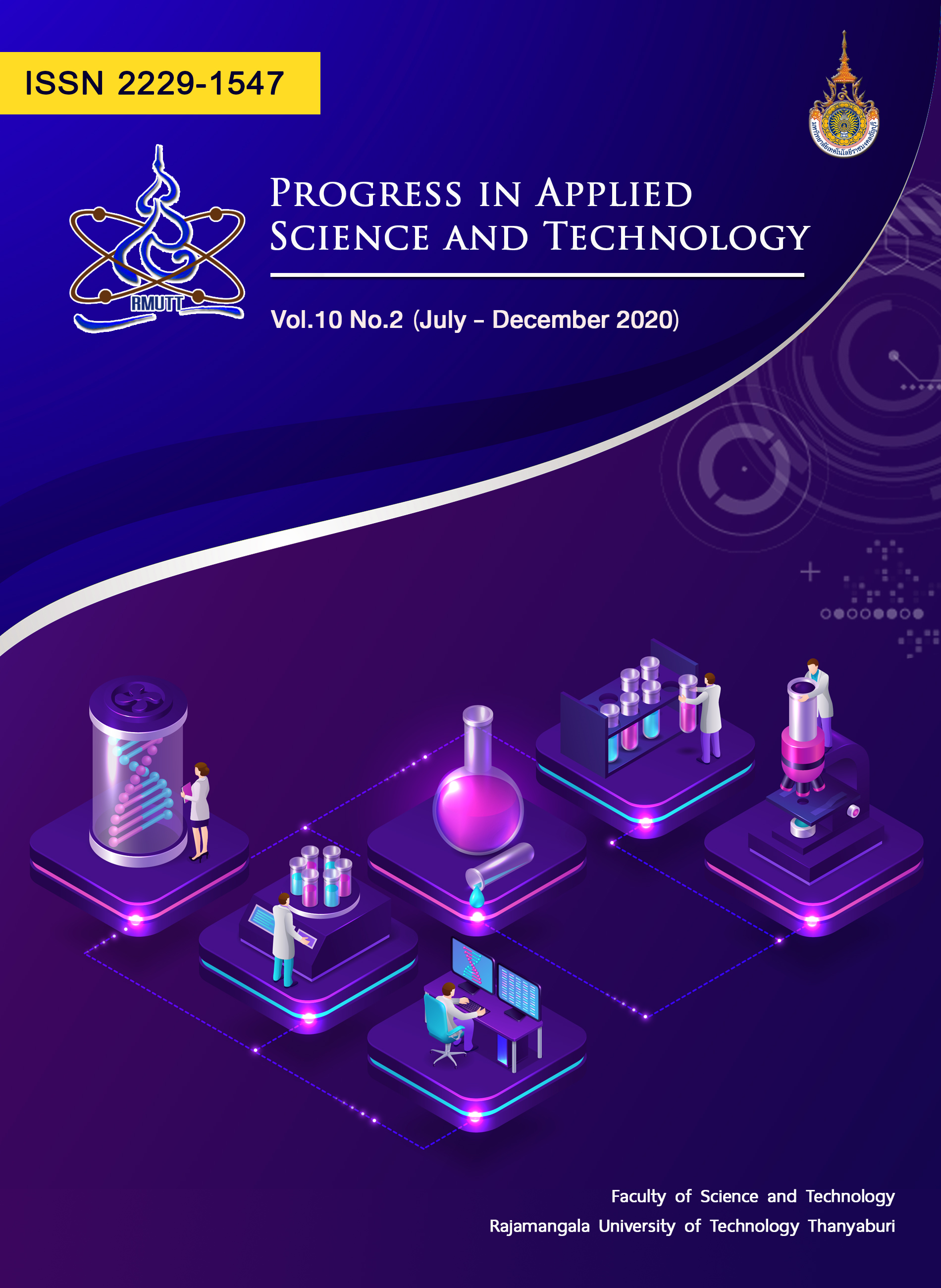Xanthones and coumarins from the twigs of Mesua ferrea L.
Main Article Content
Abstract
Five xanthones 1-5 and four phenylcoumarins 6-9 were isolated from acetone extracts of twigs of Mesua ferrea L. The structures of these compounds were elucidated by spectroscopic analysis and comparison with reported data such as 1D and 2D NMR, UV and IR spectroscopy. Compounds 4-7 were isolated from this plant for the first time. Compound 3, 1,5,6-trihydroxyxanthone, showed significant antioxidant activities with IC50 values of free radical scavenging in DPPH and ABTS assays of 45.0 and 197.0 μg/mL, respectively, as compared to the control, trolox, (77.6±1.0 µg/mL and 282.9±1.2 µg/mL for DPPH and ABTS assay, respectively). Besides, mammea A/AA cyclo F, compound 9, formed in a single crystal and was reported.
Article Details
References
Chanda S, Rakholiya K, Parekh J. Indian medicinal herb: Antimicrobial efficacy of Mesua ferrea L. seed extracted in different solvents against infection causing pathogenic strains. J. Acute Dis. 2013; 2: 277-81.
Manandhar NP. Medico botany of Gorkha district, Nepal - An elucidation of medicinal plants. Int. J. Crude Drug Res. 1990; 28: 17-25.
Lim TK. Edible medicinal and non-medicinal plant. New York: Springer; 2012.
Chakraborty T, Das MK. Oil of Mesua ferrea L. seed as a promising pharmaceutical excipient in lipid based nanoformulation. J. Appl. Pharm. Sci. 2017; 7: 133-41.
Chahar MK, Sanjaya Kumar DS, Lokesh T, Manohara KP. In-vivo antioxidant and immunomodulatory activity of mesuol isolated from Mesua ferrea L. seed oil. Int. Immunopharmacol. 2012; 13: 386-91.
Rahman SMM, Shabnom S, Quader MA. Hossain MA. Phytochemical study on the ethyl acetate extract of the leaves of Mesua ferrea Linn. Indones. J. Chem. 2008; 8: 242-44.
Wetwitayaklung P, Phaechamud T, Limmatvapirat C, Keokitichai S. The study of antioxidant activities of edible flower extracts. Acta Hortic. 2008;786:185–92.
Keawsa-ard S, Kongtaweelert S. Antioxidant, antibacterial, anticancer activities and chemical constituents of the essential oil from Mesua ferrea leaves. Chiang Mai J. Sci. 2012; 39: 455-63.
Chukaew A, Saithong S, Chusri S, Limsuwan S, Watanapokasin R, Voravuthikunchai SP, Chakthong S. Cytotoxic xanthones from the roots of Mesua ferrea L. Phytochemistry. 2019; 157: 64-70.
Aihua G, Jun L, Hongzheng F, Wenhan L. Xanthone derivatives from medicinal plant Swertia mileensis.. Zhongcaoyao. 2003; 34: 107-9.
Singh S, Gray AI, Waterman PG. Mesuabixanthone-A and mesuabixan thone-B: bis-xanthones from the stem bark of Mesua ferrea (Guttifera). Nat. Prod. Lett. 1993; 3: 53-8.
Atkinson JE, Gupta P, Lewis JR. Some phenolic constituents of Gentiana lutea. Tetrahedron. 1969; 25: 1507-11.
Guilet D, Hélesbeux JJ, Séraphin D, Sévenet T, Richomme P, Bruneton J. Novel cytotoxic 4-phenylfurano coumarins from Calophyllum dispar. J. Nat. Prod. 2001; 64: 563-68.
Verotta L, Lovaglio E, Vidari G, Finzi PV, Neri MG, Raimondi A, Parapini S, Taramelli D, Riva A, Bombardelli E. 4-Alkyl- and 4-phenylcoumarins from Mesua ferrea as promising multidrug resistant antibacterials. Phytochemistry. 2004; 65: 2867-79.
Crombie L, Games DE, McCormick A. Extractives of Mammea americana L. Part II. The 4-phenylcoumarins. Isolation and structure of Mammea A/AA, A/A cyclo D, A/BA, A/AB, and A/BB. J. Chem. Soc. (C). 1967: 2553-59.
Bandaranayake WM, Selliah SS, Sultanbawa MUS, Games DE. Xanthones and 4-phenylcoumarins of Mesua thwaitesii. Phytochemistry. 1975; 14: 265-9.
Bruker. SMART, SAINT and SADABS. Bruker AXS Inc.; Madison: Wisconsin, USA; 2003.
Farrugia LJ. WinGX and ORTEP for Windows: an update. J. Appl. Crystallogr. 2012; 45: 849–54.
Macrae CF, Bruno IJ, Chisholm JA, Edgington PR, McCabe P, Pidcock E, Rodriguez-Monge L, Van de Streek J, Taylor R, Wood PA. Mercury CSD 2.0 - new features for the visualization and investigation of crystal structures. J. Appl. Crystallogr. 2008; 41: 466–70.
Sheldrick GM. Crystal structure refinement with SHELXL. Acta Crystallogr. C. 2015; C71: 3–8.
Saeed N, Khan MR, Shabbir M. Antioxidant activity, total phenolic and total flavonoid contents of whole plant extracts Torilis leptophylla L. BMC Complement. Altern. Med. 2012; 12: 1-12.
Clinical and Laboratory Standards Institute: CLSI. M07-A8-Methods for Dilution Antimicrobial Susceptibility Tests for Bacteria That Grow Aerobically; Approved Standard-Eighth Edition. Clinical and Laboratory Standards Institute. Wayne, Pennsylvania, USA; 2009.
Jackson B, Locksley HD, Scheinmann F. Extractives from Guttiferae. Part V. Scriblitifolic acid, a new xanthone from Calophyllum scriblitifolium Henderson and Wyatt-Smith. J. Chem. Soc. (C). 1967: 785-96.
Guo A, Li J, Fu H, Lin W. Xanthone derivatives from medicinal plant Swertia mileensis. Zhongcaoyao. 2003; 34: 107-9.
Wang S, Xiao H, Liu X, Du Y, Han X, Ling X. Study on xanthone components of Swertia franchetiana. Zhongcaoyao. 2003; 34: 878-79.
Chaudhuri RK, Zymalkowski F, Frahm AW. 13C NMR-spectroscopy of polymethoxyxanthones. Tetrahedron. 1978; 34: 1837-40.






